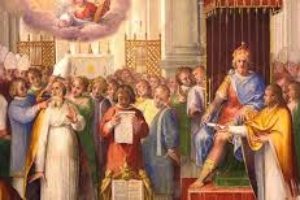This week the new issue of the Westminster Theological Journal was made available. I am grateful to have been able to contribute to the esteemed Reformed journal and I thought I’d provide a brief summary of my new article. If you’re interested in reading it the full bibliographic details are:
“David’s Tent as Temple in Amos 9:11-15: Understanding the Epilogue of Amos & Considering Implications for the Unity of the Book,” Westminster Theological Journal 73.2 (Fall 2011): 363-374.
The impetus for this study came from a fascination with the quotation of Amos 9 in Acts 15. There Luke depicts the famous ‘Jerusalem Council’ where the early church debated whether or not Gentiles should be circumcised. The Apostle James concluded that circumcision would not be required and cites Amos 9 as proof, which states that the ‘remnant of men’ will seek the Lord when ‘David’s tent’ is rebuilt. The key question at this point though is: what is David’s tent referring to? The vast majority of interpreters understand the tent to be a reference to the dilapidated ‘House’ of David’s kingly dynasty that needed restoration. However, there is a great deal of overlap in vocabulary between Acts 15 and Stephen’s speech in Acts 7. I will omit most of the gory details from this post but the important thing worth mentioning is that the word for tent in Acts 15 (σκηνή; skēnē) is used 2x in Acts 7, along with an additional cognate, to refer to the tabernacle and the temple of Israel. But the specifics of Stephen’s speech are the most interesting part. Allegations had been made against Stephen for blaspheming the temple (Acts 6.11-7.1), and in his response he recalls the instances when God’s presence and activity was clearly beyond the local and structural boundaries of the physical temple in Jerusalem (Acts 7). This speech, in turn, is itself a development of the theme of God’s presence that began in Acts 2 with the pouring out of the Spirit at Pentecost (Acts 2). Thus, there appears to be an affirmation in Acts 15 that through the inclusion of Gentiles God is establishing the eschatological temple (i.e. ‘David’s tent’). This theme of the people of God comprising the temple is not foreign to the New Testament (1 Cor 3.16-17; 6.19; 2 Cor 6.14-7.1; 1 Pet 2.4-5) and intriguingly is also specifically applied to the union of Jews and Gentiles together as the people of God as I’m suggesting here (Eph 2.11-22).
Although I became quickly convinced of this reading in Acts, the necessity of demonstrating a coherence with Amos 9 was pressing. Other NT scholars focusing on Acts 15 have concluded similarly to the reading above (cf. G. K. Beale’s The Temple and the Church’s Mission; R. Bauckham’s essay in vol 4 of The Book ofActs in its First Century Setting; J. Ådna’s essay in The Mission of the Early Church to Jews and Gentiles), yet these scholars either did not attempt to draw a correspondence between Acts and Amos, or actually denied that such correspondence existed. Now, there are many different ways to approach the issue of how the New Testament authors used or quoted the Old Testament (see the three views book by Kenneth Berding and Jonathan Lunde), but I assume that the New Testament authors normally have in mind the larger context of the passages they cite (though this is not always the case and must be demonstrated from the NT context). So I decided to address the interpretation of ‘David’s Tent’ strictly from the book of Amos to see if there was a correspondence between my reading of Acts and the original intentions of the 8th century prophet.
The scholarly consensus on the OT side of things is similar to that of NT studies in interpreting ‘David’s tent’ to be a reference to the Kingdom of David. In summary form then I’d like to provide my 5 main arguments as to why it’s preferable to view ‘David’s tent’ as a reference to the temple in Amos 9. [1]
1) Etymology. The word for ‘tent’ in Amos 9.11 is סכה (sukah), which is derived from the Akkadian word for ‘sanctuary,’ sukku. Parallels can be found elsewhere in the OT where ‘tent’ is used to refer to the dwelling place of God in Ps 27.4-5; Ps 31.21; 42.5; Lam 2.6. This is potentially the weakest argument (since the meaning of words are dependent on context), but in light of the other arguments of the study this point is worth considering.
2) The Feast of Tabernacles Context. The word for ‘tent’ (סכה ; sukah) is actually taken from the celebration of the Feasts of Tabernacles. For this celebration one would construct a temporary dwelling place to occupy for the duration of the festival in order to commemorate the wilderness wanderings of Israel. Over time this festival began to take on symbolism in association with the temple and was known as a celebration of the harvest. Interestingly, temples in the ancient world were often viewed as places that bring fertility to the land. Thus, when the vision of Amos 9.11-15 speaks of the rebuilding of the ‘tent of David’ alongside the images of the abundance of wine and agricultural success (Amos 9.13-14) it appears to be drawing upon the temple imagery associated with the Feast of Tabernacles.
3) The Nature of the Davidic Covenant. Most interpreters assume that since the tent is David’s it cannot be a reference to the Temple since he didn’t build it, but rather Solomon did. Furthermore, David is known as a famous king of Israel. In response to this objection, it is quite clear that the Davidic Covenant itself not only promised that God would build a ‘house’ for David (his kingly Dynasty), but also that David would build a ‘house’ for God (a temple). Similarly, Zech 6.12-14 anticipates that the coming Messiah would build the ‘temple of the Lord.’ Thus, the reference to David points to the messianic era of fulfillment and need not indicate that the ‘tent’ refers to the Kingdom.
4) The Failed Temple Cult in Amos. The next two arguments are the most important for my understanding of the rebuilding of David’s tent. In fact, it is because of these arguments that I suggest that the book can be read as a unity more easily than otherwise (since some critical scholars find the final verses of Amos to be too bright and cheery for his oracle of gloom). From a close reading of Amos it is clear that he is centrally concerned with the failed cult of Israel (Am 2.6-8; 3.9-10, 14; 4.1, 4-5; 5.4-5, 21-24; 6.1; 7.9; 8.3, 4-6, 10; 9.1). The people of Israel were living wicked lives yet were continuing to participate in the Temple rituals. This is Amos’ most consistent critique. In this regard it is worth reconsidering the function and purpose of Amos’ personal and autobiographical re-telling of his encounter with the Northern High Priest in Amos 7. I contend that it is related to his central concern with the cult of Israel (rather than to merely affirm his divine calling), and the fact that Amos narrates this interaction is rather telling. Thus, the vision of rebuilding ‘David’s tent’ in Amos 9 anticipates a re-establishment of the Temple system that has become corrupt.
5) The Final Oracles of Judgment. The final 3 chapters of Amos contain a sequence of 5 judgment oracles which culminate in the final scene of Amos 9.1-10. There the object of God’s judgment is the ‘altar’ (Amos 9.1). Thus, the climax of God’s judgment concerns the faulty cultic system (likely a reference to the northern cultic site of Bethel), which strengthens my 4th point above regarding Amos’ concern with the temple cult. Intriguingly, there is a clear corollary between the destruction of the ‘altar’ in 9.1, which leads to death in 9.2-10, and the rebuilding of ‘David’s tent’ in 9.11 which leads to life and abundance in 9.12-15.
Thus, I conclude that ‘David’s tent’ in Amos 9 refers to the Temple of God in the messianic era. As this text is applied to Acts 15 then, the idea is understood to refer to the building of a new community of Jews and Gentiles indwelled with the Holy Spirit. Although the referent has changed (from a structural building in Amos 9 to a community of believers in Acts 15) the sense has not. God’s special presence is indeed among his people through the Spirit and as believers today we await the fullness at the Lord’s return.
[1] As in my article I note that the strength of my arguments here are indebted to Sabine Nägele, Laubhütte Davids und Wolkensohn: eine auslegungsgeschichtliche Studie zu Amos 9,11 in der jüdischen und christlichen Exegese (Leiden: Brill, 1995).





4 Comments
Leave your reply.